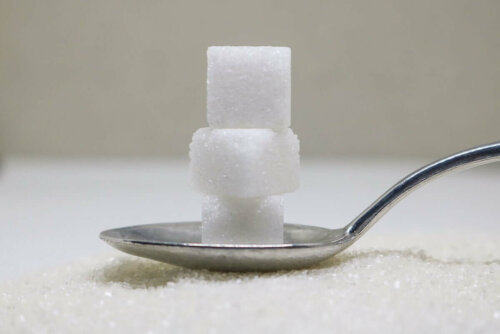Maltodextrin and its Uses


Written and verified by the nutritionist Saúl Sánchez Arias
Maltodextrin is a carbohydrate commonly found in sports supplements and processed products. It belongs to the group of high glycemic index sugars. Sometimes, it can have a thickening function. It’s a common ingredient in industrial foods. For this reason, you need to know how it can affect your body and if consuming it is safe for your health. In this article, you’ll discover maltodextrin and its uses so you know all about it the next time you read this word on a food label.
What’s maltodextrin for?
Maltodextrin has various uses, depending on the product it’s in. In ultra-processed foods, it works as a thickener. This ingredient improves the organoleptic characteristics of many foods.
This sugar is also commonly found in sports drinks to delay the onset of fatigue. According to research published in the Journal of Strength and Conditioning Research, consuming maltodextrin during physical exercise stimulates glycogen resynthesis.
Maintaining adequate levels of these nutrient stores reduces fatigue and improves performance. Glycogen is a type of glucose reserve that the liver can use when it needs to increase energy production.

How maltodextrin is obtained
Generally speaking, maltodextrin is a white soluble powder. It can be made from various foods. Some of them are rice, corn, and wheat.
To make this ingredient, the foods we mentioned must be subjected to an industrial process that alters their nutritional properties. Starches are cooked at high temperatures. Then, the manufacturers add enzymes that accelerate their decomposition. Finally, they carry out a hydrolysis process that creates maltodextrin.
The final product has an energy intake of 4 kilocalories per gram, just like any other carbohydrate. In any case, what differentiates some sugars from others is their glycemic index (GI). This is a food’s ability to increase blood glucose levels.
In this sense, maltodextrin has a higher GI than table sugar. Thus, consuming it puts a lot of stress on the pancreas. Continued use will lead to organ depletion and insulin-related problems.
Learn more here: The Glycemic Index: Description and Uses
Is it safe for health?
Although the Food and Drug Administration (FDA) considers maltodextrin safe, the truth is that its effect in sedentary people is controversial. Enough scientific evidence states that an excessive carbohydrate intake increases the risk of developing metabolic disorders.
In addition, research published in the journal Nutrients linked the intake of maltodextrin and other food additives with gut microbiota alterations. This process increases the body’s systemic inflammation and, with it, the incidence of complex and chronic diseases.
But it’s different for athletes. Experts recommend athletes to consume carbohydrates regularly to ensure replenishment of the nutrients they lose during exercise. This practice reduces the incidence of muscle injuries.
One of the goals of nutrition in sports is the replenishment of glycogen stores. According to a study also published in the journal Nutrients, athletes need to consume carbohydrates to do this.
Contraindications of maltodextrin
People with diabetes or metabolic problems should avoid ingesting sugars with high glycemic indexes. Otherwise, their health will be affected. According to experts, patients with these conditions respond better to low carb diets than to consuming this type of carbohydrate in a controlled way.
Likewise, experts state that people who suffer from intestinal dysbiosis shouldn’t consume additives such as maltodextrin on a regular basis. As they’re capable of altering the microbiota and promoting bacterial overgrowth in the small intestine, they lead to pathological conditions.
This article may also interest you: How Do Food Additives Affect Your Body?
Maltodextrin substitutes

The food industry often uses maltodextrin substitutes in order to guarantee adequate organoleptic characteristics in foods. The most common are sugar, honey, and molasses.
This doesn’t mean that these substitutes are healthier than maltodextrin itself. In fact, experts also discourage their regular consumption. The best and most practical thing is to regulate and reduce your carbohydrate intake with the goal of improving your health. This is what’s best for sedentary individuals.
Things are different in athletes, as sugars can be the main substrate to produce energy. However, they also need to control their intake to ensure that the effects don’t become harmful.
Maltodextrin and its uses: it’s a common food additive
As you’ve seen in this article, maltodextrin fulfills many functions in the food industry. However, it doesn’t benefit health in any way. In fact, it can negatively affect it.
You may not need to completely restrict its consumption. However, you do need to be aware of the products that contain this ingredient so you don’t consume them on a regular basis. To detect the presence of maltodextrin, you should read food labels.
However, if you’re an athlete, you may be able to benefit from this carbohydrate, especially if it’s added to sports drinks. If you have any doubts, consult a nutritionist.
All cited sources were thoroughly reviewed by our team to ensure their quality, reliability, currency, and validity. The bibliography of this article was considered reliable and of academic or scientific accuracy.
- Wilson PB., Does carbohydrate intake during endurance running improve performance? A critical review. J Strength Cond Res, 2016. 30: 3539-3559.
- Lee YJ., Song S., Song Y., High carbohydrate diets and food patterns and their associations with metabolic disease in the korean population. Yonsei Med J, 2018. 59 (7): 834-842.
- Alghannam AF., Gonzalez JT., Betts JA., Restoration of muscle glycogen and functional capacity role of post exercise carbohydrate and protein co ingestion. Nutrients, 2018.
- Laudisi F., Stolfi C., Monteleone G., Impact of food additives on gut homeostasis. Nutrients, 2019.
- Westman EC., Tondt J., Maguire E., Yancy WS., Implementing a low carbohydrate, ketogenic diet to manage type 2 diabetes mellitus. Expert Rev Endocrinol Metab, 2018. 13 (5): 263-272.
- Ortega, Ana Baquero. ALIMENTOS ULTRAPROCESADOS Y SU IMPACTO EN LA DIETA ACTUAL. Diss. UNIVERSIDAD COMPLUTENSE DE MADRID, 2018.
- Urdampilleta, A., et al. “Protocolo de hidratación antes, durante y después de la actividad físico-deportiva.” Motricidad. European Journal of Human Movement 31 (2013): 57-76.
- Soca, Pedro Enrique Miguel. “El síndrome metabólico: un alto riesgo para individuos sedentarios.” Revista Cubana de Información en Ciencias de la Salud (ACIMED) 20.2 (2009): 1-8.
- Martinez-Sanz, J. M., and A. Urdampilleta. “Necesidades nutricionales y planificación dietética en deportes de fuerza.” Motricidad. European Journal of Human Movement 29 (2012): 95-114.
This text is provided for informational purposes only and does not replace consultation with a professional. If in doubt, consult your specialist.








